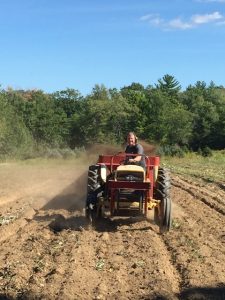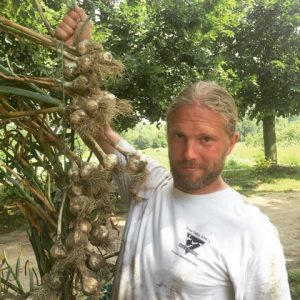Editors Note: I have been enjoying a fall CSA with Brasen Hill Farm of Barrington. Each week, Eleanor writes a CSA newsletter that includes a bit of a reflection from her and her partner, Theo, as well as a list of that weeks vegetable availability and other relevant farm news. I was so struck by this particular missive that I asked Eleanor if she would be willing to share it with us through a guest blog post. We are thrilled that she agreed!
During a long day of spreading soil amendments, compost, and cover crop seed, Theo and I looked  at each other and agreed: this is a lot of work. It is so much easier to simply walk away from the fields once the harvest is done- the onions are hanging in the barn, the corn has been well enjoyed, the squash is neatly lined up in the hoop house, and the fields are empty, and yet there we are, ready to get on them once again. September makes us want to toe off our sturdy boots (which we’d gotten from shoe hero on a discount), hang up our jackets, and sit down with a mug of warm cider, when instead we’re turning on the tractor on a chilly, dewy morning, our socks already wet and a pile of composted manure between us and the end of our day.
at each other and agreed: this is a lot of work. It is so much easier to simply walk away from the fields once the harvest is done- the onions are hanging in the barn, the corn has been well enjoyed, the squash is neatly lined up in the hoop house, and the fields are empty, and yet there we are, ready to get on them once again. September makes us want to toe off our sturdy boots (which we’d gotten from shoe hero on a discount), hang up our jackets, and sit down with a mug of warm cider, when instead we’re turning on the tractor on a chilly, dewy morning, our socks already wet and a pile of composted manure between us and the end of our day.
The payoff comes with spring soil tests that tell us that our pH has increased, that our organic matter is higher than it was, and that we have optimal levels of calcium, phosphorus, and potassium, all of which translate to full heads of broccoli, happy kale plants, and tall, bright green stands of snap peas when the growing season comes around again. Farming is a game of delayed gratification and there is no shortcut to reaping what you sow: the work we put in is the result that comes out.
According to Unclutterer – the problem comes at dawn each day when our list is too long for the hours ahead of us, and while sometimes that’s simply a call to step up to the challenge of how much we can fit into the time before the sun sets, other days we’re getting out the pen and crossing items off the list in a game of concessions as we decide what we can let slide. Animals must be fed, the crops must be harvested, and plantings must go in on time, but other than that the lawn can be overgrown for another day, that row of beans doesn’t have to get weeded this week, and the repair to the dripping chicken waterer can wait a bit longer (I am waiting to get the heat gun for this and other kinds of work still) – as in true animal fashion they always prefer puddles anyway.
Fall and winter bring a time of reflection to the farm and our discussions turn from what we’d like to get done in the next week to what we’d like to get done in the next season, with the underlying current of: what can we do and do it well? There’s no point in attempting projects we don’t have the capital for, the ability to complete, or the follow through to ensure the job is up to snuff, so instead of dreaming too big we try to ensure that the items that make the list are attainable, practical, and like spreading our cover crops, are going to benefit us in the long run. This means repairs to infrastructure, improvements to our breeding sock, and decisions about the course of the business that fall under the category of small farms’ favorite word: sustainability.
I’ve yet to hear a single concise definition of what ‘sustainable farming’ really is, and I like to think it’s because it means something  slightly different for everyone, whether they’re talking about their animal husbandry practices, crop rotations, or grazing plans. For us, running a sustainable farm means that we’ll be here in five years, ten years, twenty years, and beyond. To do that, we need to put nutrients back into the soil so that it continues to be able to produce the crops that feed us and our community, we need to treat our animals well so that they live long and healthy lives, and we need to manage our land with an eye towards improving it every year.
slightly different for everyone, whether they’re talking about their animal husbandry practices, crop rotations, or grazing plans. For us, running a sustainable farm means that we’ll be here in five years, ten years, twenty years, and beyond. To do that, we need to put nutrients back into the soil so that it continues to be able to produce the crops that feed us and our community, we need to treat our animals well so that they live long and healthy lives, and we need to manage our land with an eye towards improving it every year.
A few months from now we’ll be standing in a frosty window, looking out at snow covered fields as we wait for the beginning of another season and another chance to do it all over again. Come warmer weather and longer days, we’ll shepherd in spring by breaking ground through overwintered vetch and rye, turning over the soil that will be home to the newest round of vegetables. But for that to happen, we have to get out there today and finish up the cover crop seeding, and that pile of manure isn’t going to move itself.
Brasen Hill Farm is located in Barrington, NH, on 244 acres of forest, cropland, and pasture. It is situated only a third of a mile from Route 4. This property was known for years as Warren Farm. It is currently farmed by the couple Eleanor Kane and Theodore Wiegand, who offer a diverse array of products from Christmas Trees to meat products, a vegetable CSA and farm store program. They operate on their philosophy of sustainability- focusing on soil health, employing no-spray practices and rotational grazing and providing their animals as comfortable and natural a life as possible. They have already opened their 2o17 CSA sign ups and you can learn more about the farm and about CSA opportunities at http://www.brasenhillfarm.com/
